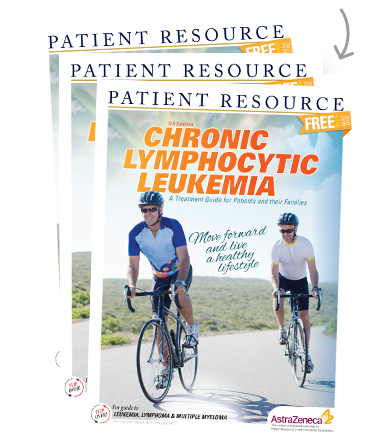Chronic Lymphocytic Leukemia
Introduction & Staging
Feeling unsettled after learning you have chronic lymphocytic leukemia (CLL) is normal, but educating yourself can help. Understanding as much as you can about this type of chronic blood cancer and about your specific diagnosis – because each CLL diagnosis is different – will help you move forward more confidently.
First, you are encouraged to find a hematologist who specializes in CLL. Your diagnosing physician should be able to give you a referral. If a CLL specialist is not nearby and traveling is not an option, look for one who will consult with your doctor. Advocacy groups, such as the CLL Society, may be able to help with referrals (cllsociety.org/programs-and-support/expert-access).
Managing CLL is a team effort, and your medical team will rely on you to do the following:
- Stay on schedule with follow-up appointments
- Communicate your symptoms
- Minimize your risk for infection
- Lead a healthy lifestyle that includes good nutrition and exercise
- Get health screenings and vaccinations
About CLL
CLL is a type of leukemia that does not typically form tumors. It usually appears in the bone marrow (the soft, spongy center of some bones), blood, lymph nodes and spleen. It develops from a type of white blood cell known as a lymphocyte. Lymphocytes make up lymphoid tissue, which is found in the lymph nodes, thymus, spleen, tonsils and other parts of the body. They are a part of the immune system.
When mature lymphocytes change and multiply uncontrollably, growing at a faster rate than usual and not dying when they should, they build up and circulate in the bloodstream and can spread to other parts of the body. They interfere with the normal production of healthy cells, including red blood cells that carry oxygen, white blood cells that fight infection and platelets that help blood to clot. Patients with CLL often have larger-than-normal lymph nodes that can appear as lumps in the neck, armpits or groin regions.
Determining your Diagnosis
Your doctor will perform a physical examination to check for pain, enlarged lymph nodes and size irregularities in your spleen and other organs.
Blood tests are used to measure blood cell counts so your doctor can assess your risk for infections and to check that your liver and kidneys are working properly before starting treatment. Genomic testing, also called molecular profiling, tests a small sample of tissue, blood or other fluid to identify specific gene abnormalities or mutations, proteins and changes in chromosomes. These tests help distinguish CLL from other forms of leukemia, determine the subtype (B-cell CLL or T-cell prolymphocytic leukemia), check for specific markers that may help predict whether the disease is high risk (having chromosome changes) or low risk, the likelihood it will progress, and help select treatment.
Possible tests include the following:
- Fluorescence in situ hybridization (FISH) to examine genes or chromosomes
- Flow cytometry to look for markers
- Immunohistochemistry to verify a CLL diagnosis
- Next-generation sequencing to test multiple genes
- Karyotyping to look for abnormal chromosomes or structures
Test results may indicate these or other factors, which help determine how the disease may behave:
- TP53 gene mutation status
- Immunoglobulin heavy chain variable (IGHV) status
- Serum B2-microglobulin concentration
- Lymphocyte doubling time (LDT)
- Deletion of chromosomes 11q, 13q or 17p
- An extra copy of chromosome 12 (trisomy)
- NOTCH1, SF3B1 or MYD88 mutations
The Modified Rai Staging System and the Chronic Lymphocytic Leukemia International Prognostic Index (CLL-IPI) further assist your doctor. Modified Rai offers information about how CLL may progress, and CLL-IPI incorporates the Rai stage and predicts the risk of disease recurrence and overall survival (see Tables 1 and 2).
Your doctor will consider the clinical stage as well as your age and other criteria to help determine the most effective treatment. Over time, your molecular test results may change. Tests should be repeated before changing the treatment strategy.
Table 1. Modified Rai Staging System
| Stage | Risk | Description |
| Stage 0 | Low | Lymphocytosis only (the blood contains a significant number of lymphocytes). |
| Stage I | Intermediate | + Adenopathy (the blood contains a significant number of lymphocytes, and lymph nodes are enlarged). |
| Stage II | Intermediate | + Enlarged spleen and/or liver (the blood contains a significant number of lymphocytes, the spleen and/or liver is enlarged, and the lymph nodes may or may not be enlarged). |
| Stage III | High | Lymphocytosis + Hgb < 11g/dL (the blood contains a significant number of lymphocytes, and the hemoglobin is less than 11 grams per deciliter). |
| Stage IV | High | Lymphocytosis + Plt < 100,000/?L (the blood contains a significant number of lymphocytes, and the platelet count is less than 100,000 microliters). |
Table 2. Chronic Lymphocytic Leukemia International Prognostic Index (CLL-IPI)
The CLL-IPI assigns weighted values for each of the following risk factors.
| Risk factors | Points |
| TP53 mutation | 4 |
| IGHV unmutated | 2 |
| Serum B2-microglobulin more than 3.5 mg/L | 2 |
| Rai Stages I-IV | -- |
| Age older than 65 years | 1 |



